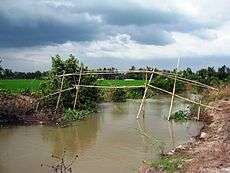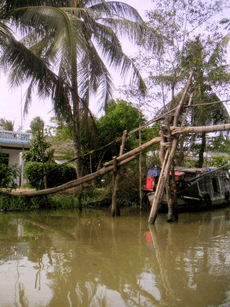Cầu khỉ


A cầu khỉ ("monkey bridge") in Vietnam is a handmade bamboo or wooden passway across a stream or gully.[1][2] The "monkey bridge", as a uniquely Vietnamese traditional symbol, was the inspiration for the title of American author Lan Cao's novel Monkey Bridge.[3]
It also called for coconut bridge (if made of coconut tree) or bamboo bridge (if made of bamboo). The bridge, with or without handrails, very difficult and dangerous to go for those who are not accustomed to. Those familiar with can carry on shoulder a mass of 20–50 kg on passing bridge.
Distribution
This type of bridge is also very popular in the Mekong Delta, because there is a system of streams. In coastal areas of the Red River Delta in the north Vietnam, such as Giao Thủy, Hải Hậu, ... (Nam Định Province) or Tiền Hải (Thái Bình Province) there are also footbridges, mainly for passersby to take care of rice in the fields. Before 1960, footbridges are also very popular in the north Vietnam. It occurs naturally follow the path of foot traffic, the bridge having to wade out of the water stream.
Competition on passing Cầu khỉ
Cầu khỉ was one of old culture signs in Vietnam. Now in industrialized regions sometimes there was a "Competition on passing Cầu khỉ by bicycle" for remembering the taste of footbridges.
Such a competition taken place in Cửa Lò town, Nghệ An Province on March 2016.[4]
References
- ↑ World's Scariest Bridges
- ↑ Cầu khỉ Việt Nam lọt top những cây cầu đáng sợ nhất
- ↑ Encyclopedia of Asian-American Literature Seiwoong Oh – 2009 Page 31 "The narrative attempts to reconstruct a family history during the Vietnam War from the Vietnamese immigrant perspective. The title of the novel is worthy of note because a monkey bridge in Vietnam is a uniquely Vietnamese traditional symbol "
- ↑ Cười đau ruột với màn thi đi xe đạp qua cầu khỉ ở Nghệ An. Videoclip. Vietnamnet, 22/03/2016. Retrieved 26/03/2016.